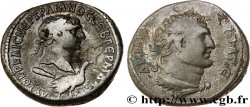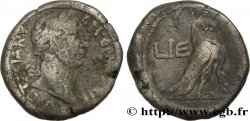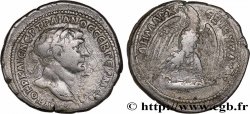brm_1033295 - TRAJANUS Denier
250.00 €(Approx. 292.50$ | 217.50£)
Quantity
Add to your cart

Type : Denier
Date: 105
Mint name / Town : Roma
Metal : silver
Millesimal fineness : 900 ‰
Diameter : 18,5 mm
Orientation dies : 6 h.
Weight : 3,37 g.
Rarity : R1
Officine: 1re
Coments on the condition:
Monnaie idéalement centrée. Superbe buste ainsi qu’un revers de style fin. Patine grise
Catalogue references :
Obverse
Obverse legend : IMP TRAIANO AVG GER DAC P M TR P COS V P P.
Obverse description : Buste lauré de Trajan à droite, avec l’égide sur l’épaule gauche (O*4).
Obverse translation : “Imperatori Traiano Augusto Germanico Dacico Pontifex Maximus Tribunicia Potestate Consuli quinto, Patri Patriæ”, (À l’empereur Trajan auguste germanique, dacique, grand pontife, revêtu de la puissance tribunitienne, consul pour la cinquième fois, père de la patrie).
Reverse
Reverse legend : S P Q R OPTIMO PRINCIPI.
Reverse description : Fortuna (la Fortune) drapée assise à gauche, tenant un gouvernail de la main droite et une corne d’abondance de la main gauche.
Reverse translation : “Senatus Populus Que Romanus Optimo Principi”, (Le sénat et le peuple romain, au meilleur des princes).
Commentary
Rubans de type 1. Il revient à l’école anglaise et aux travaux de P. V. Hill, The dating and arrangement of the Undated Coins of Rome AD. 98-148, Londres 1970, d’avoir reclassé les différentes émissions de l’atelier de Rome, grâce à la théorie des cycles et d’avoir mis en lumière l’organisation de l’atelier de Rome qui travaille en officines et non pas en fonction du métal comme l’avaient décrit les numismates du XIXe siècle.
Ribbons of type 1. It is due to the English school and the work of PV Hill, The dating and arrangement of the Undated Coins of Rome AD. 98-148, London 1970, to have reclassified the different issues of the mint of Rome, thanks to the theory of cycles and to have highlighted the organization of the mint of Rome which works in workshops and not according to the metal as the numismatists of the 19th century had described it.
Ribbons of type 1. It is due to the English school and the work of PV Hill, The dating and arrangement of the Undated Coins of Rome AD. 98-148, London 1970, to have reclassified the different issues of the mint of Rome, thanks to the theory of cycles and to have highlighted the organization of the mint of Rome which works in workshops and not according to the metal as the numismatists of the 19th century had described it.








 Report a mistake
Report a mistake Print the page
Print the page Share my selection
Share my selection Ask a question
Ask a question Consign / sell
Consign / sell
 Full data
Full data










